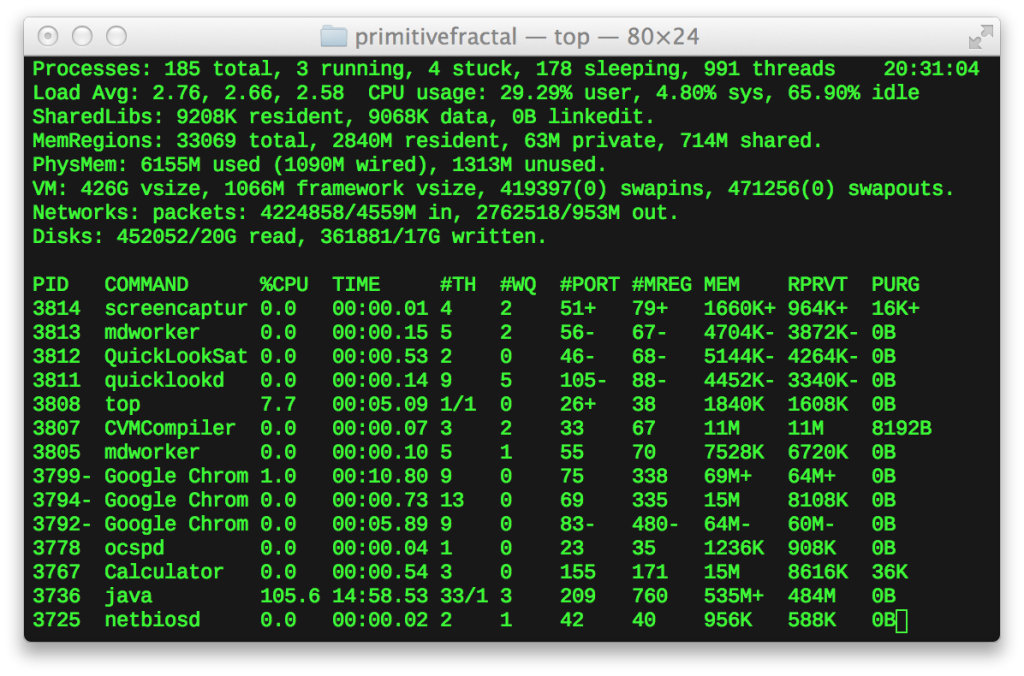SEIZURE WARNING FOR VIDEOS
UPDATE: I was able to solve the lag problem with a combination of two solutions: stopping further recursion when the origin square falls outside a certain window and stopping the creation of new levels when the pattern zooms in. On Abhishek Singh‘s suggestion, I also added comments to my code. The Github repository has been updated (see the “main” folder).
Above is a new video of the processing script in action. My original post is below…
For this week’s ICM homework, Dan Shiffman asked us to experiment with rule-based animation, motion, and interaction. I decided to expand on the primitive fractal pattern I developed last week and recorded the results in the video above. All the code is available on Github.
The first goal I tried to accomplish was zooming in on the pattern. The only feasible way I found to accomplish this was to regenerate the shape over and over again with different parameters inside a draw loop. By increasing the origin square’s width, I could make the entire pattern grow.
|
1 2 3 4 5 6 7 8 9 |
origin = 256 def draw(): background(0,0,100) noStroke() fill(7, 30, 100, 100) rect(256, 256, origin, origin) drawFourSquares(256, 256, origin) origin *= 1.01 |
Using *= rather than += allowed for smooth growth of the entire pattern due to its mathematical properties.
Next, I made the colors in the pattern shift. I accomplished this by using the frameCount variable with a modulo operation to make another variable (count) increment from 1 to the number of levels in the fractal.
|
1 2 3 4 5 6 7 8 9 10 |
def draw(): count = frameCount % (log(origin)/log(2)) background(0, 0, 100) noStroke() fill(100-(abs(log(origin)/log(2) - count - 1)/(log(origin)/log(2)))*93, 100-((log(origin)/log(2))/(log(origin)/log(2)))*70, 100, 30+((log(origin)/log(2))/(log(origin)/log(2)))*70) rect(origin, origin, origin, origin) drawFourSquares(origin, origin, origin, count) |
Finally, I combined the two effects to create one visualization:
|
1 2 3 4 5 6 7 8 9 10 11 |
def draw(): count = frameCount % (log(origin)/log(2)) background(0, 0, 100) noStroke() fill(100-(abs(log(origin)/log(2) - count - 1)/(log(origin)/log(2)))*93, 100-((log(origin)/log(2))/(log(origin)/log(2)))*70, 100, 30+((log(origin)/log(2))/(log(origin)/log(2)))*70) rect(256, 256, origin, origin) drawFourSquares(256, 256, origin, count) origin *= 1.01 |
The main issue I encountered was frame rate lag. The more detailed the fractal, the more the program would lag. I experimented with adding an acceleration factor to overcome the lag, but that seemed to make the lag accelerate along with the animation. I hope to learn more about potential solutions to overcome this issue. Perhaps there is a way to get Processing to “ignore” the shapes outside a specific field of reference. (This has since been solved. See UPDATE at the top of the post.)
To get an idea of how much processing power I’m using when I run this sketch, I used the “top” command in the terminal. These were the results:
As I observed, Java (via Processing) is using over 100% of my CPU. I would like to run this sketch on a more powerful computer at some point to see what happens.

